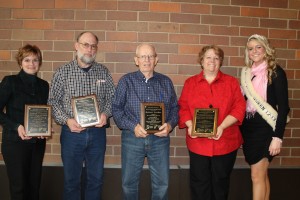See what a panel of producers said here.
WOOSTER, Ohio — Grazing sheep on pasture all 365 days of the year may seem like too big of a challenge for producers in seasonal states like Ohio.
And it just may be, for many. But with the proper grazing skills, a grazier’s offseason can be greatly reduced, if not overcome.
Producers from across the state learned the latest ways to do just that during the annual Buckeye Shepherd’s Symposium Dec. 8 at the Agricultural Technical Institute in Wooster.
The event kicked off with a keynote speech by Margaret Soulen Hinson, a sheep producer from Idaho, and president of the American Sheep Industry Association.
Although much of her presentation centered on issues facing western sheep farmers, like threats from wolves and bears, she said the industry as a whole is very interconnected, and needs to remain that way in order to thrive.
About 80 percent of the nation’s sheep are produced west of the Mississippi River, she said. However, roughly 80 percent of the actual producers are east of the Mississippi. That makes for a complex mix of ownership and a variety of geographical landscapes and regional policies.
Sheep demand the past few years has been strong, partly on the heels of lower sheep numbers. Soulen Hinson said it will be important to “build the industry to sustain the infrastructure that we have.”
Industry building
A host of staff involved with Ohio State University and the ATI talked about the ways they’re helping “build the industry” through curriculum at ATI and real-world livestock experience.
Ron Kensinger, who recently joined OSU as chairman of the Department of Animal Sciences, said sheep are special because they are excellent ruminants, meaning they can digest lower quality plant protein into microbial protein, and recycle carbon and energy.
Ruminant livestock in general can often have a positive effect on the environment and energy production, he said, calling ruminants “the ultimate biodigesters.”
Kensinger said some of the challenges facing sheep farmers include animal welfare concerns, the high price of land, and the high price feed. He said the high feed prices are partly a result of the nation’s ethanol mandate — known as the Renewable Fuels Standard — which requires a minimum amount of corn to be used for the production of ethanol.
Better grazing
Multiple breakout sessions were held throughout the day, with a general focus on making better graziers.
In a producer panel on grazing, Bruce Rickard of Knox County discussed how he has diversified his farm to become almost exclusively grass-based, without making hay.
He manages 180 acres of grass and his objective is to graze sheep and other livestock year-round, when possible. His sheep only come off the pasture in February and lamb in March in the barn, where he is forced to feed hay.
“The ruminants are a really good place to save on feed if you can eat every blade of grass on your farm,” he said.
But Rickard and other producers also are mindful not to “overgraze,” which damages the re-growth potential of the grass.
In a speech on utilizing proper forages, Forage Manager Dave Robison recommended leaving at least 4 inches of grass when grazing.
Robison, who works for Legacy Seeds, talked about dozens of plant and grazing scenarios to optimize yield and grazing potential. He recommended choosing the right species for each producer’s plot, the right combination and the proper grazing schedule, and fertilizing.
Grazing has a lot to like, he said, because it is the cheapest way to feed ruminants, it’s the best prediction of profit for a farmer, and the profit margin can be widened simply by expanding the days that grazing is available.
Some of the species he discussed included chicory, which has an excellent drought resistance, clovers, pearl millet, oats, radishes and turnips.
Award winners
Various awards were presented in the afternoon.
The Ralph Grimshaw Memorial Scholarship award of $1,000 went to Megan Hunker of Bellevue, who is majoring in animal sciences at Ohio State University. Adam High, a senior at Elgin High School, was recognized as the winner of the state FFA Sheep Proficiency award.
The Environmental Stewardship Award went to Shirley and Francis Steffee of Steffee Farms, in Dresden. They also were nominated for the American Sheep Industry environmental stewardship award.
Distinguished service awards were presented to Farm and Dairy Editor Susan Crowell; David Inbody, Robert Gucker, Val Jorgensen and Leslie Jordan, board members; and Ohio Farm Bureau Federation Accounting, represented by Irene Messmer, Bill Riddle, Tammy Moore and Teri Weathers. Farm and Dairy was nominated for the American Sheep Industry Association media award.
The Master Shepherd award went to Dan Schlichter of Washington Court House.
The Friend of the Ohio Sheep Industry award went to Ken and Kathy Kark Of New Washington, and Guy and Pat Flora of Cardington. They were founders and longtime editors of The Shepherd magazine.












